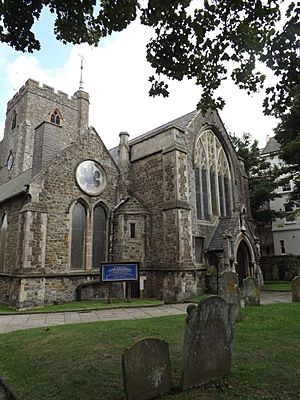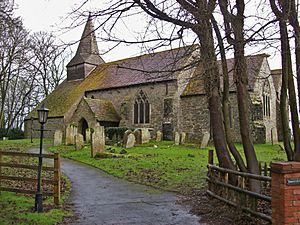Eanswith facts for kids
Quick facts for kids SaintEanswith |
|
|---|---|
| Born | c.630 Kent |
| Residence | Folkestone |
| Died | c.650 Folkestone |
| Venerated in | Roman Catholicism, Anglicanism, Eastern Orthodoxy |
| Major shrine | St Mary and St Eanswythe's Church, Folkestone |
| Feast | 12 September (Western Christianity) 31 August (Orthodoxy) |
| Attributes | crown, staff, book and sometimes a fish |
| Major works | Founded Folkestone Abbey |
Saint Eanswith (also spelled Eanswythe or Eanswide) was an Anglo-Saxon princess. She was born around 630 CE in Kent, England, and passed away around 650 CE in Folkestone, England. Eanswith is famous for founding Folkestone Priory. This was one of the very first Christian communities for women in Britain. In 2020, scientists published research about what might be her remains.
Contents
Who Was Saint Eanswith?
Eanswith was a princess from the Kingdom of Kent. Her father was King Eadbald, who ruled Kent from 616 to 640 CE. Her mother was Emma, who might have been a princess from a place called Francia. Eanswith also had two brothers, Eormenred and Eorcenberht. Her grandfather, Æthelberht of Kent, was the first king in Anglo-Saxon England to become a Christian.
Founding a New Community
Tradition says that Eanswith started the Benedictine Folkestone Priory. This was the first nunnery (a place where nuns live) in England. Her father, King Eadbald, helped her build it.
While the monastery was being built, a non-Christian prince wanted to marry Eanswith. King Eadbald remembered that his sister, Æthelburh, had married a non-Christian king, King Edwin. That marriage led to Edwin becoming a Christian. However, Eanswith chose not to marry the prince.
This monastery was the first one for women in England. Eanswith lived there with other women who wanted to dedicate their lives to God. They might have learned from monks who came to England with Augustine in 597 CE.
Honoring Saint Eanswith
Eanswith lived at the abbey until she passed away.
The first monastery site was abandoned by the 900s. The sea started to wash it away. A new monastery built in 1095 also faced this problem. So, in 1137, a new site further inland was chosen for Folkestone Priory. A church was built there and dedicated to St Mary and Eanswith.
Moving Her Remains
Saint Eanswith's special day is September 12. This is the day her remains were moved to the new church in 1138. The word "translation" here means moving a saint's body or relics to a new, special place.
During a time called the Reformation, the priory was closed. The priory church then became the local church for Folkestone, called St Mary and St Eanswythe's Church.
A Special Discovery
In 1885, during repairs at the church, some human bones were found. They were inside a lead box called a reliquary, hidden in the church's north wall. Experts said the box was from the 1100s, and the bones belonged to a young woman. People thought these might be the remains of Saint Eanswith, hidden away during the Reformation to keep them safe.
What Symbols Represent Her?
Sometimes, Eanswith is shown with a fish. She also has an abbess's staff (a stick used by the head of a monastery), a crown, and a book. The fish symbol might be connected to Folkestone being a fishing port.
New Research on Her Remains
In 2017, historians and archaeologists from Canterbury Christ Church University and Folkestone Museum started working together. They needed special permission to remove and study the human remains found in 1885.
In 2020, experts who study bones (called osteologists) examined the remains. They tested teeth and bones and found that they all came from one person. This person was likely a woman, aged between 17 and 21. There were no signs that she had been unhealthy or didn't get enough food. All these details matched what was known about Eanswith.
Scientists at Queen's University Belfast used radiocarbon dating to find out how old the bones were. They confirmed the remains were from the mid-600s. This project, called 'Finding Eanswythe', received money from the Heritage Lottery Fund.
It's impossible to be 100% sure that the remains are Saint Eanswith. But if they are, they would be the oldest remains of an English saint ever found. They would also be the oldest remains of a relative of a British monarch.
Churches Named After Her
Besides the church in Folkestone, other churches are named after Eanswith:
- St Eanswith's Church, Brenzett, Kent, England
- St Eanswythe's Church, Altona, Victoria, Australia
See also



